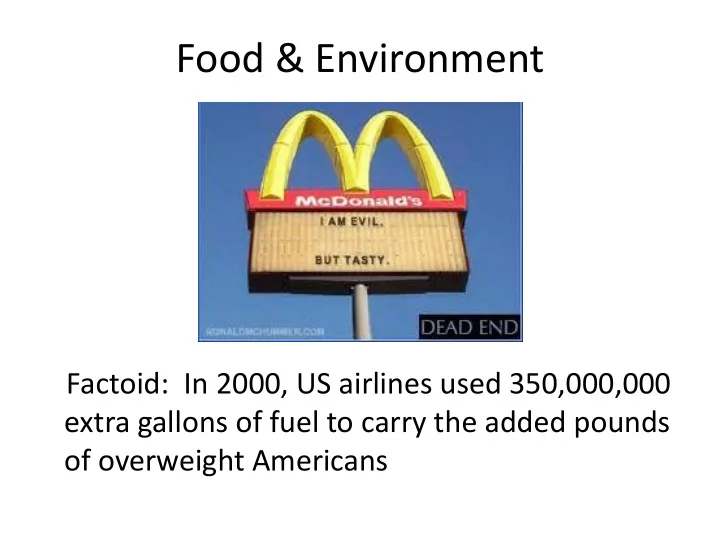

Food & Environment Factoid: In 2000, US airlines used 350,000,000 extra gallons of fuel to carry the added pounds of overweight Americans
Quiz: McMichael et al., 2007 2. Describe two ways that current livestock production creates greenhouse gases.
Vocab – McMichael et al., 2007 • Ischaemic – constricting of blood vessels • Paleolithic – stone age • Sedentarism – sitting around • Zoonoses – diseases originating from animals • Somatic – human generated • Militate – powerfully prevent
Global Deforestation Hotspots
Global Vertebrate Biodiversity Jenkins et al., 2013
Forest Carbon Storage
Global Impacts of Deforestation • Loss of biodiversity and local extinctions • Changes to hydrologic cycle • Conversion of carbon sink to carbon source
Why does habitat loss/fragmentation reduce biodiversity?
Loss of species richness with different amounts of deforestation Nichols et al., 2007
Species Richness (aka number of species) Species area relationship
Species area relationship examples Ricklefs & Lovette, 1999
Species area relationship examples Genoways et al., 2007
Explanations for the species area relationship • Small populations are susceptible to extreme events (storms, fire, predation)
Explanations for the species area relationship • Small populations are susceptible to extreme events (storms, fire, predation) • Smaller area = lower habitat diversity
Explanations for the species area relationship • Small populations are susceptible to extreme events (storms, fire, predation) • Smaller area = lower habitat diversity • Island biogeography suggests small ‘islands’ have lower species richness
Island Biogeography • Species diversity in a location is a function of colonization (adds species) and extinction (subtracts species)
Island Biogeography • Colonization is more likely with proximity to ‘mainland’ (i.e. source of species) • Extinction is more likely if the land area (i.e. available niches/resources) is small
Projected extinctions based on species area relationships Global modeled extinction based on habitat loss up to 1990 (tropical extinctions would be much higher if we used habitat loss up to 2015) Thomas et al., 2004
Resource Intensive Foods
Resource Intensive Foods • Meat protein takes anywhere from 6-20 x the energy to produce as soy protein Pimentel & Pimentel, 2003
The classic resource pyramid
Drivers of Livestock Production Demand : • Population growth (mainly developing countries) • Income growth (mainly east and south Asia) • Lifestyle changes Supply : • Cheap energy • Cheap grain • Deforestation & degradation are externalities
Corn Subsidies in the U.S. 1995-2009 2009 subsidy for corn, rice, wheat & soy: $15,400,000,000 2009 subsidy for all fruits, vegetables & organic crops: $800,000,000
By-products of Corn Subsidies High fructose corn syrup
How Different Livestock Compare Pimentel & Pimentel, 2003
Energetic Efficiency of Different Foods >100 means we get more out than we put in Eschel & Martin, 2006
Corn Production Costs Per Hectare Pimentel & Pimentel, 2003
Land Use Associated with Livestock Production • 34,000,000 km 2 of pasture globally (26% of land) • 23,000,000 km 2 of cropland globally (18% of land) • ~1/3 of cropland is dedicated to production of animal feed
~9% of global CO 2 equivalent greenhouse gas emissions
~8% of global CO 2 equivalent greenhouse gas emissions Livestock’s Long Shadow: FAO
Sources of emissions from livestock Livestock account for ~ 18% of global GHG emissions McMichael, 2007
Grass-fed beef: Emissions central
Reduce Consumption: Food Choices - Beef production creates 10x more CO 2 equivalent than other foods Why more CO 2 equivalent from extensive? - Grass-fed cows release 4x more methane than grain fed cows Machinova et al., 2015
Nitrogen Pollution from Livestock Production Nitrogen inputs into the Mississippi watershed under current conditions (top) and with animal feed converted to equivalent vegetable protein (bottom) Donner, 2007
Household Actions: Food Choices • Tradeoff between intensification (non-organic) and extensification (organic) in order to produce the same food quantity • Without synthetic fertilizers we could only feed about half of the current global population with current food choices
Americans don’t follow food recommendations 25-30% of a typical American diet is fat General Rule : The more processed your food is, the more energy it took to make
Solutions? • Fix the food pricing system – Need a market for externalities (carbon cap and trade; polluter pays policies) – Remove or reduce subsidies • Education • Social values & personal actions
Discuss remaining questions from McMichael
Organic Food Production • Reduces nitrogen leaching • Retains more soil carbon
Land Degradation from Livestock • Increased soil erosion • Incised riparian areas • Change in ecosystem structure Soil erosion in Indonesia
Water Use for Livestock Production • Cows drink a lot of water. It takes an average of 1000 gal of water to produce 1 gal of milk
Water Use for Livestock Production • Cows drink a lot of water. It takes an average of 1000 gal of water to produce 1 gal of milk • Livestock production uses 8% of global water resources (primarily for feed)
Current Water Stress
Recommend
More recommend